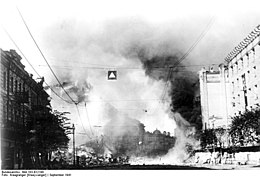
Back معركة كييف (1941) Arabic کیئف دؤیوشو (۱۹۴۱) AZB Битка при Киев (1941) Bulgarian Batalla de Kíiv (1941) Catalan Bitva o Kyjevský kotel Czech Slaget om Kijev (1941) Danish Schlacht um Kiew (1941) German Μάχη του Κιέβου Greek Batalo de Kievo (1941) Esperanto Batalla de Kiev (1941) Spanish
| Battle of Kiev (1941) | |||||||||
|---|---|---|---|---|---|---|---|---|---|
| Part of Operation Barbarossa on the Eastern Front of World War II | |||||||||
 Explosion of a Soviet radio-mine in Kiev (September 1941) | |||||||||
| |||||||||
| Belligerents | |||||||||
|
|
| ||||||||
| Commanders and leaders | |||||||||
| Strength | |||||||||
|
25 infantry divisions 9 armoured divisions 544,000[1] | Initial 627,000[2] | ||||||||
| Casualties and losses | |||||||||
|
Total: 128,670[3]
|
700,544 men[2] 411 tanks and SPGs destroyed[6]343 aircraft destroyed[6] 28,419 guns and mortars lost[7] | ||||||||
The First Battle of Kiev was the German name for the major battle that resulted in an encirclement of Soviet troops in the vicinity of Kiev during World War II, the capital and most populous city of the Ukrainian Soviet Socialist Republic.[8] This encirclement is the largest encirclement in the history of warfare by number of troops. The battle occurred from 7 July to 26 September 1941 as part of Operation Barbarossa, the Axis invasion of the Soviet Union.
Much of the Southwestern Front of the Red Army (commanded by Mikhail Kirponos) was encircled, but small groups of Red Army troops managed to escape the pocket in the days after the German panzers attacked east of the city; including the forces of Marshal Semyon Budyonny, Marshal Semyon Timoshenko and Commissar Nikita Khrushchev. Kirponos was trapped behind German lines and was killed while trying to break out.
The battle was an unprecedented defeat for the Red Army, and was more damaging than the Battle of Białystok–Minsk of June–July 1941. The encirclement trapped 452,700 Soviet soldiers, 2,642 guns and mortars, and 64 tanks, of which only 15,000 soldiers escaped from the encirclement by the 2nd of October. The Southwestern Front suffered 700,544 casualties, including 616,304 killed, captured, or missing during the battle. The 5th, 37th, 26th, 21st, and 38th armies, consisting of 43 divisions, were almost annihilated and the 40th Army suffered many losses. Like the Western Front before it, the Southwestern Front had to be recreated almost from scratch.
Despite being referred to as the "Battle of Kiev", the city of Kiev itself played a small and peripheral role in the overall battle. The battle took place over a large area in eastern Ukraine, with Kiev being the focal point of Soviet defenses, and of the German encirclement.
Adolf Hitler, the leader of the Third Reich, described the Battle of Kiev as "the biggest battle in the history of the world", while Joseph Goebbels, the German minister of propaganda, called it "the greatest battle of annihilation of all time".[9] Historian Evan Mawdsley described the battle as the Ostheer's "greatest triumph of the war in the East and the Red Army’s greatest single disaster", while historian Michael Jones dubbed the battle to be "the Wehrmacht’s greatest victory of the war".[10]
Cite error: There are <ref group=lower-alpha> tags or {{efn}} templates on this page, but the references will not show without a {{reflist|group=lower-alpha}} template or {{notelist}} template (see the help page).
- ^ G.K. Zhukov. Nhớ lại và suy nghĩ. tập 2. trang 99
- ^ a b Glantz 1995, p. 293.
- ^ "1941". Archived from the original on 25 October 2012. Retrieved 9 August 2014.
- ^ Г. Ф. Кривошеев, Россия и СССР в войнах ХХ века, Москва, 2001, p. 270
- ^ Kirchubel 2013, p. 283.
- ^ a b Krivosheev 1997, p. 260.
- ^ Liedtke 2016, p. 148.
- ^ Stahel 2012, pp. 3–4, 81, 345–346.
- ^ Stahel 2012, pp. 223, 300.
- ^ Stahel 2012, p. 346.
© MMXXIII Rich X Search. We shall prevail. All rights reserved. Rich X Search